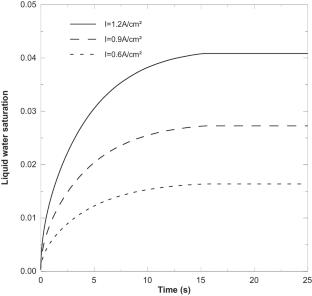质子交换膜燃料电池中气体扩散层性质对液态水输运及瞬态响应影响的数值模拟
IF 1.3
4区 工程技术
Q2 ENGINEERING, AEROSPACE
引用次数: 0
摘要
本文建立了质子交换膜燃料电池多孔气体扩散层(GDL)中水运移的一维两相瞬态模型。该模型基于液态水和氧气在多孔GDL中质量输运的数值分辨率,用于测量电流密度、GDL厚度和GDL渗透率等各种设计和操作参数对系统整体性能的影响。本文章由计算机程序翻译,如有差异,请以英文原文为准。

Numerical Modeling of the Influence of Gas Diffusion Layer Properties on Liquid Water Transport and Transient Responses in a Proton Exchange Membrane Fuel Cell
In this study, a one-dimensional, two-phase transient model has been developed to study the transient behavior of water transport in the porous gas diffusion layer (GDL) of a proton exchange membrane fuel cell PEM fuel cell. This model based on the numerical resolution of the mass transport of liquid water and oxygen in the porous GDL is used to gauge the effects of various design and operational parameters, namely, the current density, GDL thickness and GDL permeability, on the overall performance of the system.
求助全文
通过发布文献求助,成功后即可免费获取论文全文。
去求助
来源期刊

Microgravity Science and Technology
工程技术-工程:宇航
CiteScore
3.50
自引率
44.40%
发文量
96
期刊介绍:
Microgravity Science and Technology – An International Journal for Microgravity and Space Exploration Related Research is a is a peer-reviewed scientific journal concerned with all topics, experimental as well as theoretical, related to research carried out under conditions of altered gravity.
Microgravity Science and Technology publishes papers dealing with studies performed on and prepared for platforms that provide real microgravity conditions (such as drop towers, parabolic flights, sounding rockets, reentry capsules and orbiting platforms), and on ground-based facilities aiming to simulate microgravity conditions on earth (such as levitrons, clinostats, random positioning machines, bed rest facilities, and micro-scale or neutral buoyancy facilities) or providing artificial gravity conditions (such as centrifuges).
Data from preparatory tests, hardware and instrumentation developments, lessons learnt as well as theoretical gravity-related considerations are welcome. Included science disciplines with gravity-related topics are:
− materials science
− fluid mechanics
− process engineering
− physics
− chemistry
− heat and mass transfer
− gravitational biology
− radiation biology
− exobiology and astrobiology
− human physiology
 求助内容:
求助内容: 应助结果提醒方式:
应助结果提醒方式:


